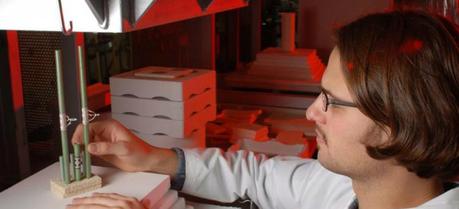 Ph.D. Student Daniel Storjohann (Mechanical Engineering Department) fabricates ceramic fuel cells in the Colorado Fuel Cell Center. (Credit: Colorado School of Mines)
Ph.D. Student Daniel Storjohann (Mechanical Engineering Department) fabricates ceramic fuel cells in the Colorado Fuel Cell Center. (Credit: Colorado School of Mines)Researchers at Colorado School of Mines are going to develop a single-cell fuel cell device that can produce electricity from natural gases.
A team of two metallurgical and materials engineering professors and three mechanical engineering professors at Colorado School of Mines has been awarded $1 million through Advanced Research Projects Agency-Energy’s Reliable Electricity Based on Electrochemical Systems Program to develop high-efficiency, medium-temperature fuel cells that can produce electricity from natural gases.
“Imagine you could replace the water heater in your home with a similarly-sized fuel cell unit that could also produce the electricity for your home,” metallurgical and materials professor Ryan O’Hayre said. “You wouldn’t need the electric grid anymore. This would be great for remote cabins, but also for people that want to “get off the grid.”
O’Hayre, and professors Neal Sullivan, Robert Braun, Jianhua Tong and Sandrine Ricote, are working to address three opportunities for this new fuel cell technology: lowering the cost and temperature, and designing a fuel cell that can operate on a variety of fuels.
“I am hoping for the day when I can buy a natural-gas powered fuel cell for my home that could provide both my electricity and hot-water with an overall combined efficiency of more than 80 percent,” O’Hayre said. “I am optimistic that this could happen before my baby daughter goes to college.”
In the next two years, the team will demonstrate feasibility in a single-cell fuel cell device and then scale it to a larger size with multiple fuel cells connected together to produce a larger amount of power.
Sullivan will test durability and performance of the fuel cell stack, while Braun will build models to guide the optimal design of the system and estimate the cost and performance on a commercial scale. O’Hayre will develop new materials and synthesis processes to fabricate the “heart” of the fuel cell device.

